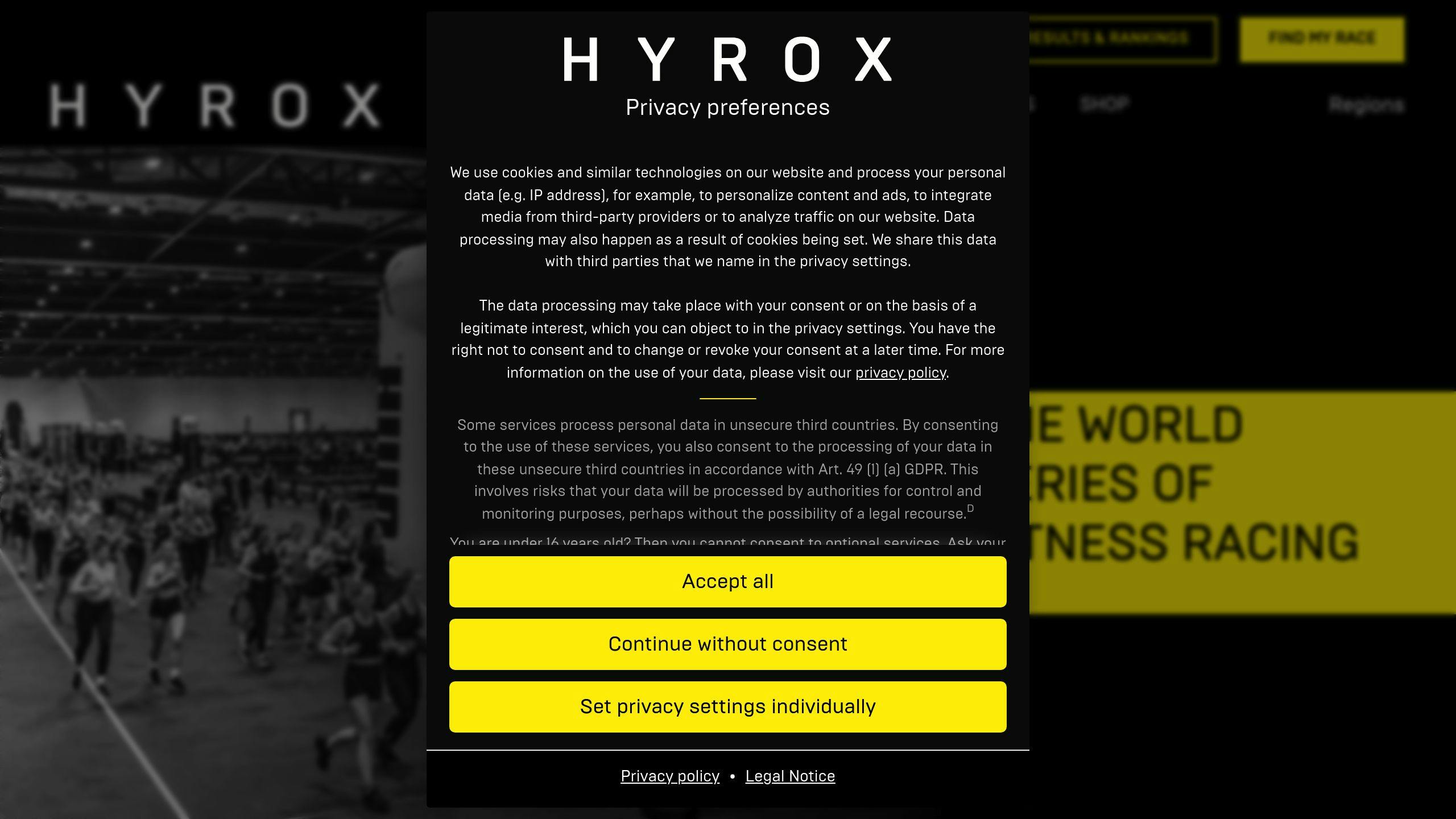Want to dominate your next Hyrox race? This 4-week plan combines strength, endurance, and hybrid workouts to prepare you for peak performance. Here's what you'll focus on:
- Strength Training: Barbell thrusters, suitcase deadlifts, and back squats to power through sled pushes and carries.
- Endurance Work: Interval runs, long-distance running, and Ski Erg sessions to build stamina for 8.7km of race running.
- Hybrid Workouts: AMRAPs, EMOMs, and race simulations to mimic competition conditions.
- Recovery: Foam rolling, mobility drills, and structured rest to prevent injuries and improve performance.
- Race Prep: Tapering, mental strategies, and pacing techniques for a strong finish on race day.
This plan uses progressive overload, race simulations, and recovery strategies to sharpen your skills and keep you injury-free. Whether it’s boosting your sled push strength or perfecting transitions, this guide ensures you’re race-ready. Let’s break it down!
18 Exercises EVERY Hyrox Program Needs!

Core Elements of Hyrox Training
For advanced Hyrox athletes, balancing strength and endurance is key to excelling in the race.
Strength Training for Hyrox Events
Building strength is a critical part of Hyrox preparation, focusing on exercises that directly enhance race performance. Here are some essential movements:
- Barbell thrusters: Boost upper body power.
- Suitcase deadlifts: Strengthen unilateral movement.
- Back squats: Target lower body strength [4].
These exercises help develop the power needed for tasks like sled pushes and farmer's carries.
Endurance Training: Running and Cardio
Endurance is just as important, considering the race includes about 8.7km of running [2]. A well-rounded approach includes:
- Interval running: Short bursts of high-intensity effort to build speed.
- Long-distance runs: Steady efforts to improve aerobic capacity.
- Ski erg sessions: Practice specific movements while varying intensity.
| Training Type | Purpose | How to Do It |
|---|---|---|
| Interval Running | Build speed and power | Short, intense bursts |
| Long-Distance Runs | Develop aerobic endurance | Steady pace over longer distances |
| Ski Erg Sessions | Improve specific endurance | Mix technical practice with effort |
Pacing is critical - train to conserve energy for the race's later stages.
Combining Strength and Endurance in Workouts
While strength and endurance are vital on their own, combining them is where Hyrox athletes truly shine. Workouts like AMRAP, EMOM, and race simulations integrate running with strength exercises to mimic race-day conditions [3].
To push limits further, add HIIT finishers at the end of runs. These not only improve performance under fatigue but also build mental resilience [3].
These strategies are the foundation of the 4-week plan, designed to prepare athletes for peak performance on race day.
The 4-Week Hyrox Training Plan
This 4-week plan is designed to help you build strength, endurance, and race-specific skills for peak performance at Hyrox. It combines structured workouts with progressive intensity to prepare you mentally and physically.
Week 1: Strength and Endurance Foundation
The first week is all about building a strong base. You'll focus on key strength exercises while improving your aerobic capacity.
| Day | Focus | Key Workouts |
|---|---|---|
| Monday | Strength | Heavy compound lifts + 2km run |
| Tuesday | Endurance | Interval running + ski erg practice |
| Wednesday | Active Recovery | Light cardio + mobility work |
| Thursday | Hybrid | Strength circuits + running intervals |
| Friday | Skills | Race movement practice + 3km run |
| Saturday | Long Run | 5km steady-state run |
| Sunday | Rest | Mobility and recovery |
Week 2: Boosting Intensity
In Week 2, the focus shifts to increasing both workout volume and intensity. You'll incorporate EMOM (Every Minute on the Minute) and AMRAP (As Many Rounds As Possible) sessions to simulate race conditions. Add exercises like sandbag lunges and dumbbell cleans to mimic competition demands. Gradually increase weights in your strength sessions, but always prioritize proper form.
Week 3: Balancing Recovery and Intensity
Week 3 is about finding the right balance between intense training and recovery. Here's what the week looks like:
- Two high-intensity race simulation days to mimic race conditions.
- Three moderate training days to maintain fitness levels.
- Two active recovery days focused on mobility and light cardio.
This approach helps your body adapt while avoiding burnout.
Week 4: Race Week Preparation
The final week is all about fine-tuning. Reduce workout volume but maintain intensity to stay sharp. Focus on race-specific movements, efficient training sessions, and mental preparation. Pay close attention to nutrition and hydration to ensure you're in top condition.
sbb-itb-8bcd5e0
Tips for Advanced Hyrox Athletes
Progressive Overload in Training
Progressive overload is essential for building strength and improving performance. Instead of random increases, follow a structured approach. For example, gradually raise weights for strength exercises by 2-5% each week. If you're pushing a sled at 100kg, aim for 102-105kg in the following week [1].
Keep track of key metrics like running pace, weights, rest periods, and workout duration. This data helps you measure progress and make informed adjustments.
Recovery and Injury Prevention
Recovery plays a crucial role in sustaining high performance and avoiding injuries. A well-planned recovery routine should include both active and passive techniques. For instance, foam rolling for 10-15 minutes after workouts helps reduce muscle tension and improve flexibility. Combine this with other methods like ice baths and mobility exercises [3].
Here’s a suggested recovery plan:
| Time | Activity | Purpose |
|---|---|---|
| Post-Workout | Foam rolling | Ease muscle tension |
| Evening | Light mobility work | Preserve flexibility |
| Rest Days | Light mobility work | Preserve flexibility |
| Weekly | Sports massage | Relieve chronic tension |
Ice baths can also be beneficial. Spend 10-15 minutes in water at 10-15°C after intense sessions to help reduce inflammation.
Race Simulation Workouts
Race simulations are a must for both mental and physical readiness. These workouts should mimic Hyrox competition demands. For example, alternate between 1km runs and 50m sled pushes or pulls, using competition weights and distances [2].
Transitions and pacing are critical during these sessions. Practice smooth and efficient transitions to save time. For elite athletes, focus on minimizing unnecessary movements and timing transitions accurately. On erg machines, prioritize maintaining optimal power output rather than going all-out, as excessive effort might not lead to better results [4].
Use performance data from your training to fine-tune your strategy, ensuring you're maximizing efficiency without wasting energy [2].
Final Steps Before Race Day
Making Final Adjustments
As race day approaches, the focus shifts to fine-tuning your preparation and recovery to ensure you're ready to perform at your best. This phase, often called tapering, helps your body recover and build strength while keeping you sharp.
Cut back on training volume but keep some intensity in your workouts to stay in race shape. This structured reduction allows your body to repair and recharge. Stick to your established routines, especially when it comes to nutrition and sleep, and avoid making any big changes at the last minute.
Here’s a simple guide for your final week:
| Days Before Race | What to Focus On |
|---|---|
| 7-5 Days | Cut training volume to 60%, foam rolling, mobility exercises |
| 4-3 Days | Drop volume to 40%, light stretching, prioritize extra rest |
| 2 Days | Practice race techniques, active recovery, mental visualization |
| 1 Day | Gentle mobility work, mental prep, and full rest |
Use visualization techniques to mentally rehearse transitions and pacing. Double-check all your race-day gear for comfort and fit - this is NOT the time to try anything new.
Plan your pacing strategy for both running segments and functional exercise stations. Focus on consistent effort rather than starting too fast, which can lead to burnout.
Be ready to adjust your plan if race day conditions - like weather or terrain - throw you a curveball. Having backup strategies in mind can help you stay calm and confident no matter what comes your way. With these final tweaks, you'll be set to take on race day with focus and determination.
FAQs
How to improve HYROX performance?
To boost your HYROX performance, focus on three main areas: hybrid training, pacing strategies, and proper recovery.
Incorporate compound lifts like barbell thrusters alongside endurance exercises such as sled pushes and kettlebell carries. This combination mimics race conditions and helps build both power and stamina [4]. Be strategic with your energy - put more effort into high-impact areas, as machines like the SkiErg often offer limited time savings [2].
Here’s an example of a training session:
- 5x5 barbell thrusters, followed by sled pushes
- 1km runs paired with kettlebell carries
- Practice station-to-station transitions for smoother execution
Pro Tips for Advanced Athletes
- Use floor plans to estimate running distances and streamline transitions between stations [2].
- Add HIIT finishers after runs to improve fatigue resistance [3].
- Schedule deload weeks every 4–6 weeks to avoid overtraining [1].
Balancing strength (e.g., thrusters, deadlifts) with endurance (e.g., sled pushes, running) is key. Don’t overlook recovery - mobility work and foam rolling can help keep you in top form. Fine-tuning these elements can prepare you for elite-level competition.



